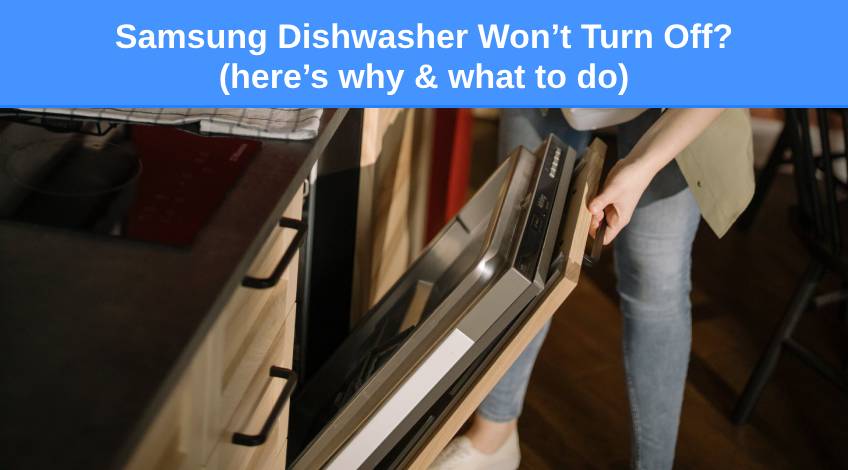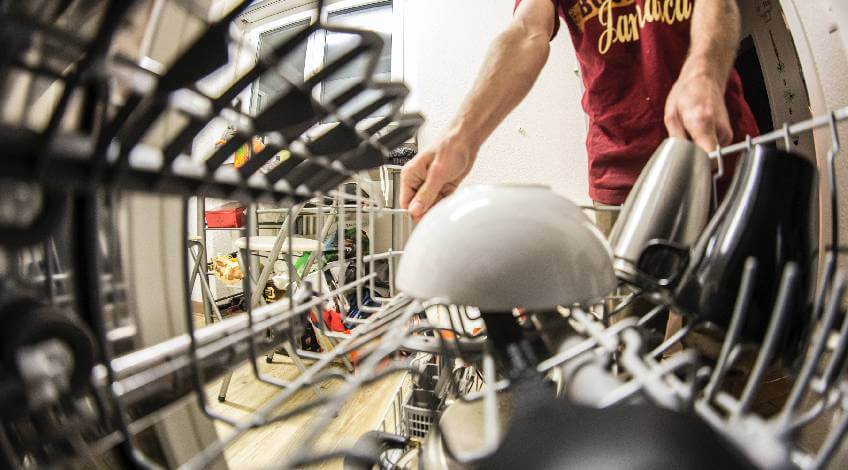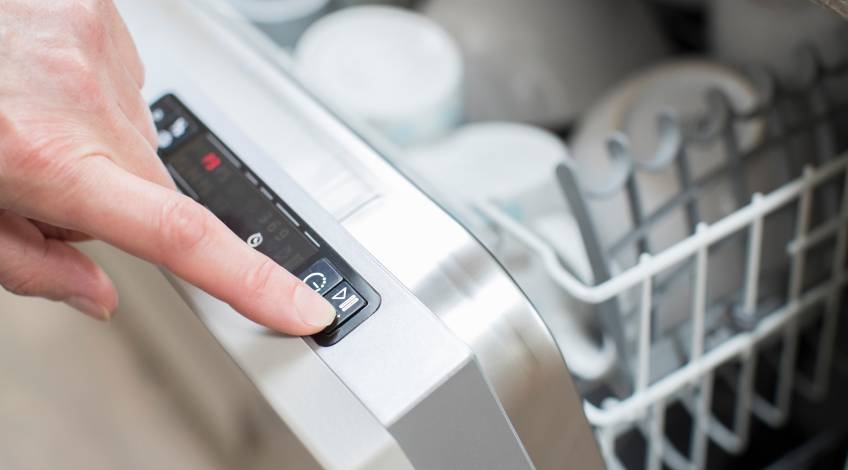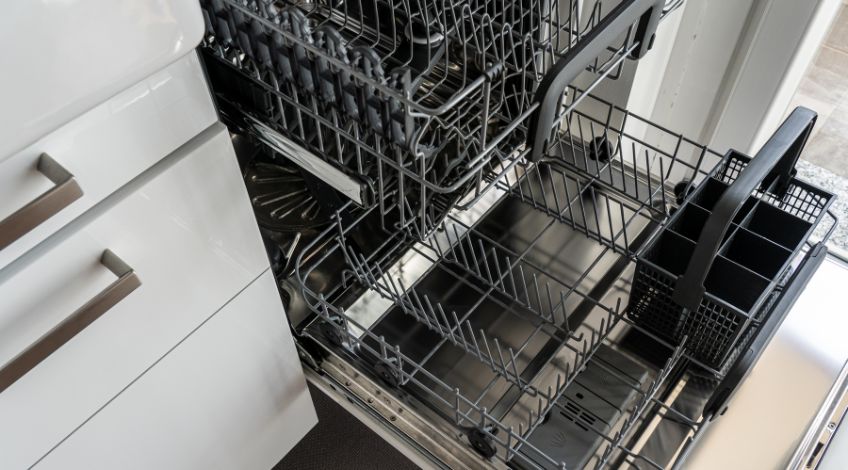
Samsung Dishwasher Won’t Turn Off? (here’s why & what to do)
The dishwasher is a great time and labour saving device which over time we come to rely on. Which makes it annoying and worrying if it starts to malfunction. If you own a Samsung dishwasher and it won’t turn off, keep reading.
In this article we identify all of the reasons why a Samsung dishwasher could fail to turn off and give practical solutions to this problem. Many of these solutions can be performed at home by anyone with just the basic DIY skills.
Why Won’t The Samsung Dishwasher Turn Off?
There are several reasons why a Samsung dishwasher might not turn off which include;
| Probable Cause | Solution |
|---|---|
| Leakage Issues | Mop up any excess water, fix the leak |
| Error Code Displayed | Check the error code in your user manual, reset the appliance |
| Defective Control Board | Reset the appliance if problem persists contact a technician |
| Sanitise Cycle Selected | The appliance won’t turn off until the door is opened manually when the sanitise cycle has been selected |
| Defective Timer Motor | Check the timer motor and replace if necessary |
| Heating Issues | Check the heating components and replace if necessary |
| Defective Turbidity Sensor | Inspect the turbidity sensor and replace if necessary |
Let’s take a closer look at each of these issues;
Leakage Issues

Samsung dishwashers have a moisture sensor that messages the control board to initiate drainage as soon as it detects moisture. Whilst the dishwasher is draining water, it will prevent the appliance from turning off.
There are any number of reasons why the moisture sensor detects water including defective hoses, spilled liquid or the remains of a previous flooding incident. There’s also the possibility that the dishwasher isn’t level due to an installation error.
Plus, using too much or an incorrect detergent can also lead to too much moisture. Or at least the sensor detects the soap suds and presumes they are water. Then there’s the possibility of the door seal or gasket showing signs of wear that could lead to water escaping.
Finally there are mechanical issues that could result in the same thing which include; Damaged filter, defective water pump or a damaged detergent dispenser.
Fixing Leakage Issues
To fix any of these issues you will need to investigate until you find the cause. You may need to replace the inlet or drainage hose or at least tighten the clamps holding them in place. Check to see if the dishwasher is level using a spirit level and adjust the feet accordingly.
Unplug the dishwasher and move it to mop up any spilled liquid, ensure you are using the correct detergent in the right quantity, after removing any soap suds from the tub and dispenser.
You will also have to check the filter, which might just need cleaning but could need to be replaced, check the water pump for any leaks or malfunctions and if necessary replace it. Then check the detergent dispenser for any signs of damage.
Finally, you will need to inspect all of the rubber seals or gaskets on the door and other components making sure they are not damaged and are fitted correctly in place.
Error Code Displayed
It’s always good practice to check the display screen for any error codes or flashing lights if your Samsung dishwasher won’t turn off. If you do find an error code, consult your user manual for what it indicates.
This will give you a better idea of what’s wrong with the appliance. Once you have this information, you’ll be better equipped with the knowledge of how to solve the issue.
However, in some cases the error code could be displayed falsely by a defective control board. You can check whether the error code is correct by disconnecting the power supply for 10 to 15 minutes to allow all electricity to dissipate.
Then reconnect the power and see if the error code has gone, if so, the dishwasher might work properly again and you’ll be able to turn it off.
Defective Control Board
The control board sends and receives messages from all of the component parts of the dishwasher. Unfortunately, it is sensitive and easily damaged. All it takes is power surge to fry some of the wiring or connections.
If this happens it could cause the control board to send a message to display a false error code as mentioned above. These false error codes can affect the way the dishwasher operates which could prevent it from turning off.
The first thing to do is disconnect the appliance from the power supply for 10 to 15 minutes. Then reconnect the power and see if the error code has gone.
If the error code remains and you’re certain that the area the code relates to is not faulty, you’ll need to get the control board checked out. This is a job best left to an expert because the control board is a sensitive component that is easily damaged.
Sanitise Cycle Selected

On Samsung dishwashers the sanitise cycle takes far longer than other cycles with an estimated 90 minutes extra duration compared to a regular wash cycle. It also works using an increased temperature compared to other cycles.
On regular cycles, the dishwasher automatically turns off once the cycle has completed. However, when the sanitise cycle has been selected, the display screen remains active even after the cycle has finished and only shuts down once manually turned off.
To do this you need to open the dishwasher door carefully because it will still be very hot inside. Leave the door open to allow the steam to escape for around 10 minutes.
Once the appliance cools down, it will automatically turn off. If you don’t want to fill your kitchen with steam, you can use the power button to finish the cycle and leave the door shut.
Defective Timer Motor
Every cycle or programme on the Samsung dishwasher is regulated by the timer. Which is powered by a motor that can become defective over time.
If the timer motor malfunctions it can prevent the appliance from starting, cause cycles to take far longer than usual or prevent the appliance from turning off.
As the timer motor is typically located in the same area as the control board, we recommend getting a technician to investigate it for you. The technician will check the timer motor for continuity using a multimeter and replace it if necessary.
Heating Issues

Every cycle on the Samsung dishwasher involves heating to some degree. If one of the components that are a part of the heating process become damaged or develop a fault, it can prevent the dishwasher from turning off.
That’s because the dishwasher will be stuck in the heating phase and will not continue until it completes that phase. There are a number of parts that could cause this issue including the thermistor, the heating rod or even a wiring issue.
As checking the heating system involves dismantling the dishwasher’s panels, we recommend getting a technician to do this for you.
Defective Turbidity Sensor
The turbidity sensor detects how clear the water that’s used inside the dishwasher is. In doing so, it determines just how long each cycle takes to complete. If the turbidity sensor is defective, it could send an incorrect message to the control board.
The turbidity sensor is typically located in the pump housing. Unfortunately, accessing it involves removing panels from the appliance which can be a step too far for most DIYers. Which is why we recommend getting a technician to check this and replace the turbidity sensor if necessary.
SEE ALSO: Samsung Dishwasher Touchpad Not Working? Here’s why & what to do
Frequently Asked Questions
To reset your Samsung dishwasher all you need to do is disconnect it from the power supply for 10 to 15 minutes. After the time has elapsed, reconnect the power and switch the dishwasher on. The dishwasher should have been reset.
There are several reasons why your Samsung dishwasher won’t turn off which include; it has leakage issues, it has a defective control board, a defective turbidity sensor, a defective timer motor, heating issues or the sanitise cycle has been selected.
Unlike other cycles on a Samsung dishwasher, the appliance will not automatically turn off after the sanitise cycle unless you manually open the door first. Once the door has been opened, it will take around 10 minutes for the cycle to finish.
Also, follow us on Pinterest ...



